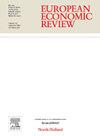是工人还是公司推动了外资收购的工资差距?
IF 2.4
2区 经济学
Q1 ECONOMICS
引用次数: 0
摘要
外资收购的公司支付更高的工资。工资差距可能与工人构成(例如,挑选高质量工人)或公司层面的溢价(例如,生产率提高)有关。我们建议对荷兰的普遍雇主-雇员数据进行动态分解,以了解收购后工资差距的驱动因素。在被收购后,工资差距从1%上升到5%,而公司层面的溢价约占这一差距的四分之三。劳动力构成的贡献最初是不存在的,但增长到工资差距的五分之一,这完全是由新员工推动的。公司层面的溢价与更高的管理层薪酬、员工培训和公司的国际化战略有关。我们展示了工人分类和公司层面发展的隐含相对重要性如何随着收购反事实的假设而变化。本文章由计算机程序翻译,如有差异,请以英文原文为准。
Do workers or firms drive the foreign acquisition wage gap?
Foreign-acquired firms pay higher wages. The wage gap may arise with worker composition (e.g., sorting of high-quality workers) or firm-level premia (e.g., productivity improvements). We propose a dynamic decomposition on The Netherlands’ universal employer–employee data to understand the drivers of the post-acquisition wage gap. The wage gap rises from 1% to 5% after the acquisition, and firm level premia account for roughly three-quarters of the gap. The contribution of the workforce composition is initially absent, but grows to one-fifth of the wage gap, driven solely by new hires. Firm-level premia associate with higher management pay, worker training, and firms’ internationalization strategies. We show how the implied relative importance of worker sorting and firm-level development varies with assumptions on the counterfactual of the acquisition.
求助全文
通过发布文献求助,成功后即可免费获取论文全文。
去求助
来源期刊

European Economic Review
ECONOMICS-
CiteScore
4.70
自引率
3.60%
发文量
170
期刊介绍:
The European Economic Review (EER) started publishing in 1969 as the first research journal specifically aiming to contribute to the development and application of economics as a science in Europe. As a broad-based professional and international journal, the EER welcomes submissions of applied and theoretical research papers in all fields of economics. The aim of the EER is to contribute to the development of the science of economics and its applications, as well as to improve communication between academic researchers, teachers and policy makers across the European continent and beyond.
 求助内容:
求助内容: 应助结果提醒方式:
应助结果提醒方式:


